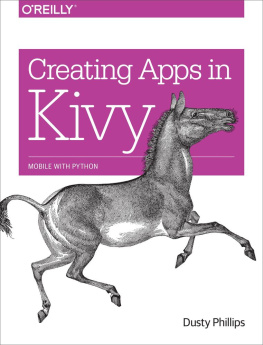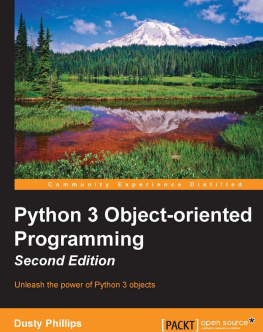Dusty Phillips - Creating Apps in Kivy
Here you can read online Dusty Phillips - Creating Apps in Kivy full text of the book (entire story) in english for free. Download pdf and epub, get meaning, cover and reviews about this ebook. year: 2014, publisher: OReilly Media, genre: Computer. Description of the work, (preface) as well as reviews are available. Best literature library LitArk.com created for fans of good reading and offers a wide selection of genres:
Romance novel
Science fiction
Adventure
Detective
Science
History
Home and family
Prose
Art
Politics
Computer
Non-fiction
Religion
Business
Children
Humor
Choose a favorite category and find really read worthwhile books. Enjoy immersion in the world of imagination, feel the emotions of the characters or learn something new for yourself, make an fascinating discovery.
- Book:Creating Apps in Kivy
- Author:
- Publisher:OReilly Media
- Genre:
- Year:2014
- Rating:5 / 5
- Favourites:Add to favourites
- Your mark:
Creating Apps in Kivy: summary, description and annotation
We offer to read an annotation, description, summary or preface (depends on what the author of the book "Creating Apps in Kivy" wrote himself). If you haven't found the necessary information about the book — write in the comments, we will try to find it.
Each chapter includes exercises, using examples that run on Python 3 and Python 2.7. Learn how Kivy simplifies mobile development with its cross-platform API and domain-specific Kv language, and why this free and open source toolkit is ideal for commercial products.
Design custom widgets with the Kv language
Delve into Kivy events, event handlers, and properties
Dynamically change which Kivy widgets are displayed
Understand and apply iterative development principles
Create basic animations, using Canvas and graphics primitives
Store local data with Kivys powerful key value store
Add basic gestures to switch between app views
Improve your apps usability with Kivys built-in widgets
Deploy the app to your Android or iOS device, using Buildozer
Dusty Phillips: author's other books
Who wrote Creating Apps in Kivy? Find out the surname, the name of the author of the book and a list of all author's works by series.













